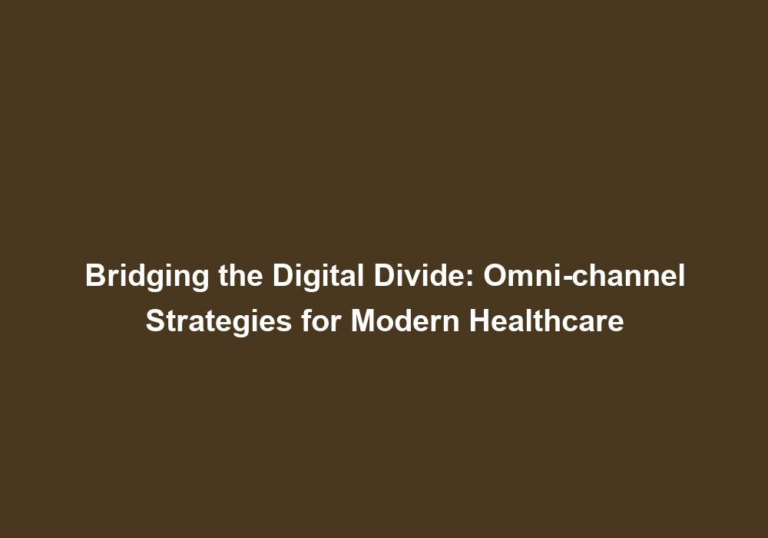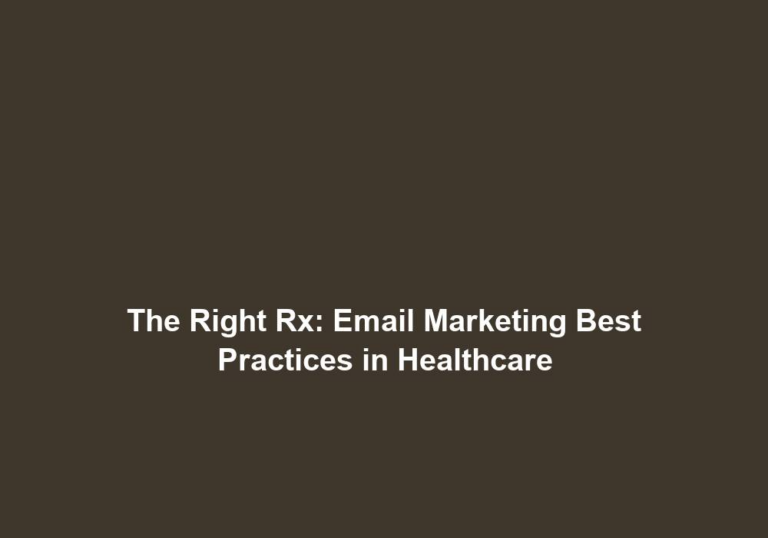Inbox Insights: Crafting Meaningful Health Communications via Email
In today’s fast-paced digital world, email has become an essential tool for communication and information exchange. This holds true in the healthcare industry as well, where effective and meaningful communication is crucial for building trust, educating patients, and promoting overall well-being. Crafting compelling and engaging health communications via email can have a profound impact on patient engagement, adherence to treatment plans, and overall satisfaction with healthcare services.
Importance of Health Communications via Email
Email has emerged as a popular medium for health communications due to its accessibility, convenience, and cost-effectiveness. It provides an opportunity for healthcare providers to reach a wide audience, reinforce important health messages, and foster a sense of connection with patients.
- Accessibility: Email can be accessed on various devices, including smartphones, tablets, and computers, making it convenient for patients to stay connected with their healthcare providers wherever they are.
- Convenience: With email, patients can receive important health information and updates without the need for in-person appointments or phone calls. This saves time and effort for both patients and healthcare providers.
- Cost-effectiveness: Sending emails is a cost-effective way to communicate with a large number of patients simultaneously. It eliminates the need for printing and mailing physical materials, reducing expenses for healthcare organizations.
By leveraging email as a communication tool, healthcare professionals can effectively educate patients about preventive care, upcoming appointments, medication reminders, and important health-related updates. This targeted approach ensures that patients receive the right information at the right time, leading to better health outcomes.
Tailoring Emails for Patient Engagement
To ensure that health communications via email are effective and meaningful, it is crucial to tailor them to the specific needs and preferences of the individual patient. Personalization plays a key role in engaging patients and fostering a sense of trust.
-
Segmentation: Divide your patient population into various segments based on demographics, medical conditions, or specific health concerns. This allows you to deliver targeted messages that resonate with each group. For example, you can create separate email campaigns for patients with diabetes, heart disease, or mental health conditions, addressing their unique needs and challenges.
-
Address the Patient by Name: Begin the email with a personalized greeting that addresses the patient by name. This helps create a sense of personal connection and shows that the communication is specifically intended for them. Personalization goes beyond addressing the patient by name; it also involves tailoring the content to their specific health condition or interests.
-
Use Patient-Centric Language: Frame the content of the email around the patient, focusing on their needs, concerns, and goals. Use language that is simple, jargon-free, and easy to understand. This helps to avoid confusion and ensures that the message is comprehensible to all recipients. Avoid using medical jargon or technical terms that may alienate or confuse patients.
-
Provide Relevant Information: Deliver content that is relevant to the patient’s specific health condition or interests. For example, if a patient is managing diabetes, include information about healthy eating, blood sugar monitoring, and the importance of regular exercise. Tailoring the content to their needs shows that you understand their unique challenges and are committed to supporting their overall well-being.
By personalizing health emails, healthcare providers can establish a deeper connection with patients, increase their engagement, and empower them to take an active role in managing their health.
Structure and Formatting for Clarity
To optimize the readability and comprehension of health communications via email, it is important to structure and format the content effectively. Here are some guidelines:
Use Headings and Subheadings
Breaking down the email into sections with clear headings and subheadings helps patients quickly navigate through the content and locate the information they need. It also improves the readability of the email, allowing patients to skim through the email and easily find the relevant sections. For example, if the email is about managing stress, you can use headings such as “Techniques for Relaxation” and “Importance of a Healthy Lifestyle.”
Utilize Bullet Points and Lists
When presenting information, consider using bullet points or numbered lists to convey key points or steps. This helps to make the content more scannable and digestible for patients. For example:
- Five Tips for Managing Stress:
- Practice relaxation techniques such as deep breathing and meditation.
- Engage in regular physical activity to release endorphins and reduce stress.
- Maintain a healthy diet and stay hydrated.
- Prioritize sleep and ensure you get enough rest.
- Seek support from friends, family, or a mental health professional.
Using bullet points helps patients easily identify and remember the key takeaways from the email. It breaks down complex information into actionable steps, making it more practical and applicable to their daily lives.
Incorporate Visuals and Infographics
Visual aids, such as relevant images, charts, or infographics, can enhance the impact of health communications via email. They provide a visual representation of complex information and make it easier for patients to understand and retain key messages. For example, an infographic explaining the benefits of regular exercise can be included in an email about maintaining a healthy lifestyle. Visuals can capture attention, communicate information more effectively, and make the email more engaging.
By structuring the content with headings and subheadings, utilizing bullet points and lists, and incorporating visuals and infographics, healthcare providers can ensure that their health communications via email are clear, concise, and visually appealing.
Best Practices for Successful Health Communications via Email
To ensure that health communications via email are successful in achieving their intended goals, consider the following best practices:
-
Clear Call-to-Action: Clearly state the desired action or next steps for the patient. Whether it is scheduling an appointment, filling out a survey, or accessing educational resources, provide a prominent and easily identifiable call-to-action button or link. Make it clear what you want the patient to do next and provide any necessary instructions or additional information.
-
Mobile-Optimization: With the increasing use of smartphones, it is essential to optimize health emails for mobile devices. Ensure that the email design and layout are responsive and compatible with various screen sizes, allowing patients to access and engage with the content seamlessly. Test the email on different devices and ensure that it displays properly, with all elements visible and accessible.
-
Engage in Two-Way Communication: Encourage patients to respond to emails and ask questions. Provide contact information or a dedicated email address for inquiries, feedback, or concerns. Respond promptly and thoughtfully to foster a sense of trust and open communication. Engaging in two-way communication shows that you value their input and are committed to providing personalized care.
-
Consistency and Frequency: Establish a consistent schedule for sending health emails to patients. Whether it is weekly newsletters, monthly updates, or appointment reminders, maintain a regular cadence to keep patients engaged and informed without overwhelming their inboxes. Consistency helps build trust and establishes a routine for patients to expect and look forward to receiving valuable health information.
-
Data Privacy and Security: Ensure that health emails comply with privacy regulations, such as the Health Insurance Portability and Accountability Act (HIPAA). Implement necessary measures to protect patient information and maintain strict data security protocols. Patients need to feel confident that their personal health information is safe and secure when communicating via email.
By implementing these best practices and tailoring health communications via email to meet the individual needs of patients, healthcare providers can foster meaningful connections, empower patients to take an active role in their healthcare, and ultimately improve health outcomes.
Remember, effective health communications via email go beyond simply sending messages. They require careful planning, personalized content, and thoughtful consideration of the patient’s perspective. With a focus on clarity, engagement, and patient-centeredness, healthcare professionals can leverage email as a powerful tool for crafting meaningful health communications.





